Wild Animals
Bonnet Macaque
Common Name: Bonnet Macaque
Scientific Name: Macaca radiate
The bonnet macaque (Macaca radiata) is a macaque endemic to southern India. Its distribution is limited by the Indian Ocean on three sides and the Godavari and Tapti Rivers along with a related competing species of rhesus macaque in the north. The land use changes in last few decades has resulted in changes in its distribution boundaries with the rhesus macaque, raising concern for its status in the wild. It is 35-60 cm long plus a tail of 35-68 cm. Males weigh 5.5 to 9 kg., females 3.5 to 4.5 kg. The bonnet macaque feeds on fruits, nuts, seeds, flowers, invertebrates and cereals. In southern India this macaque exists as commensal to humans, feeding on food given by humans and raiding crops and houses
Lion-Tailed Macaqure
Common Name: Lion-Tailed Macaqure
Scientific Name: Macaca silenus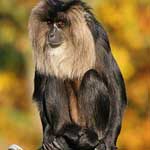
The lion-tailed macaque (Macaca silenus) is an Old World monkey that is endemic to the Western Ghats of South India. The hair of the lion-tailed macaque is dark brown or black. Its outstanding characteristic is the silver-white mane which surrounds the head from the cheeks down to its chin, which gives this monkey its German name of "Beard Ape". The hairless face is black colored. With a head-to-tail length of 45 to 60 cm and a weight of 3 to 10 kg, it ranks among the smaller macaques. The tail is medium length with a length of approximately 25 cm and is a black tuft at the end, similar to a lion's tail. The male's tail-tuft is more developed than that of the female. Gestation is approximately six months. The young are nursed for one year. Sexual maturity is reached at four years for females, six years for males. The life expectancy in the wild is approximately 20 years, while in captivity up to 30 years.
Slender Loris
Common Name: Slender Loris
Scientific Name: Loris tardigradus
The red slender loris (Loris tardigradus) is a small, nocturnal prosimian native to the rainforests of Sri Lanka. This small, slender primate is distinguished by large forward-facing eyes used for precise depth perception, long slender limbs, a well-developed index finger, the absence of tail, and large prominent ears, which are thin, rounded and hairless at the edges. The soft dense fur is reddish-brown color on the back, and the underside is whitish-grey with a sprinkling of silver hair. Its body length on average is 7–10 in (180–250 mm), with an average weight of a mere 3–13 oz (85–370 g). The Red Slender Loris favors lowland rainforests (up to 700 m in altitude), tropical rainforests and inter-monsoon forests of the south western wet-zone of Sri Lanka. Masmullah Proposed Forest Reserve harbors one of few remaining Red Slender Loris populations, and is considered a biodiversity hotspot. Females are dominant. The female reaches her sexual maturity at 10 months and is receptive to the male twice a year. This species mates while hanging upside down from branches; individuals in captivity will not breed if no suitable branch is available.
Tiger
Common Name: Tiger
Scientific Name: Panthera tigris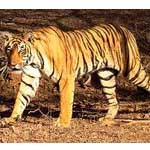
The tiger (Panthera tigris), a member of the Felidae family, is the largest of the four "big cats" in the genus Panthera. The tiger is native to much of eastern and southern Asia, and is an apex predator and an obligate carnivore. The larger tiger subspecies are comparable in size to the biggest extinct felids, reaching up to 3.3 metres (11 ft) in total length, weighing up to 300 kilograms (660 pounds), and having canines up to 4 inches (100 mm) long. Aside from their great bulk and power, their most recognisable feature is a pattern of dark vertical stripes that overlays near-white to reddish-orange fur, with lighter under parts. The most numerous tiger subspecies is the Bengal tiger, while the largest is the Siberian tiger. Tigers have a lifespan of 10-15 years in the wild, but can live longer than 20 years in captivity. They are highly adaptable and range from the Siberian taiga to open grasslands and tropical mangrove swamps.
Panther, Leopard
Common Name: Panther, Leopard
Scientific Name: Panthera pardus
The leopard, Panthera pardus, is a member of the Felidae family and the smallest of the four "big cats" in the genus Panthera, the other three being the tiger, lion, and jaguar. The leopard was once distributed across eastern and southern Asia and Africa, from Siberia to South Africa, but its range of distribution has decreased radically because of hunting and loss of habitat. It is now chiefly found in sub-Saharan Africa; there are also fragmented populations in Indonesia, Pakistan, India, Sri Lanka, Indochina, Malaysia, and China. Because of its declining range and population, it is listed as a "Near Threatened" species by the IUCN.
Leopard Cat
Common Name: Leopard Cat
Scientific Name: Prionailurus bengalensis
The leopard cat (Prionailurus bengalensis) is a small wild cat of South and East Asia. Since 2002 it has been listed as Least Concern by IUCN as it is widely distributed but threatened by habitat loss and hunting in parts of its range. There are twelve leopard cat subspecies, which differ widely in appearance. The leopard cat's name is derived from the leopard-like spots prevalent in all subspecies, but its relation to the leopard is distant.
Jungle Cat
Common Name: Jungle Cat
Scientific Name: Felis chaur
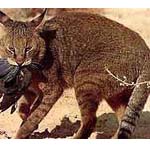 The jungle cat (Felis chaus) is a medium-sized cat and considered the largest remaining species of the wild cat genus Felis. The species is also called the swamp lynx but is not closely related to the lynxes. Felis chaus is listed as Least Concern in the IUCN Red List of Threatened Species as it is widespread and common particularly in India. Population declines and range contraction are of concern, particularly in Egypt, in the Caucasus, and in south-western, central and Southeast Asia.
The jungle cat (Felis chaus) is a medium-sized cat and considered the largest remaining species of the wild cat genus Felis. The species is also called the swamp lynx but is not closely related to the lynxes. Felis chaus is listed as Least Concern in the IUCN Red List of Threatened Species as it is widespread and common particularly in India. Population declines and range contraction are of concern, particularly in Egypt, in the Caucasus, and in south-western, central and Southeast Asia.
Rusty Spotted Cat
Common Name: Rusty Spotted Cat
Scientific Name: Prionailurus rubiginosus 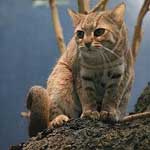
The Rusty-spotted Cat (Prionailurus rubiginosus) is the cat family's smallest member and found only in India and Sri Lanka. It has been listed as Vulnerable by IUCN in 2002 as the total effective population size is below 10,000 mature individuals, with a declining trend due to habitat loss, and no subpopulation containing more than 1,000 mature breeding individuals.
Malabar Civet
Common Name: Malabar Civet
Scientific Name: Viverra megaspila civettina
The Malabar Large-spotted Civet (Viverra civettina), is a civet and is also known as the Malabar Civet. The species was once common along the lowland coastal tracts of Kerala and Karnataka in South India. It became rare by the beginning of the 20th century, but was still often used for producing civetin musk in the 1960's. In 1990, isolated populations of the Malabar Large-spotted Civet still survived in less disturbed areas of South Malabar. In 1999, fewer than 250 mature individuals were thought to survive in the wild.
Small Indian Civet
Common Name: Small Indian Civet
Scientific Name: Viverricula indica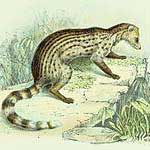
The Small Indian Civet (Viverricula indica) or Rasse is a species of civet found across south and South-east Asia as well as in the Indonesian archipelago. The species has been introduced to Madagascar. It is slender, agile in climbing trees, has no erectile mane and lives in holes in rocky and brushy locations. In captivity, it is easily tamed and feeds on small animals, which it catches with cat-like dexterity. Hence it is often kept in houses as a ratter, and also for the sake of its civet, which is artificially removed from the glands
.
Common Mongoose
Common Name: Common Mongoose
Scientific Name: Herpestes edwardsii
The Indian Gray Mongoose or Common Grey Mongoose (Herpestes edwardsii) is a species of mongoose mainly found in southern Asia mainly India, Pakistan, Nepal, Sri Lanka and some other parts of Asia. The gray mongoose is commonly found in open forests, scrub lands and cultivated fields, often close to human habitation. It lives in burrows, hedgerows and thickets, among groves of trees, taking shelter under rocks or bushes and even in drains. It is very bold and inquisitive but wary, seldom venturing far from cover. It climbs well. Usually found singly or in pairs. It preys on rodents, snakes, birds’ eggs and hatchlings, lizards and variety of invertebrates. Along the Chambal river it occasionally feeds on gharial eggs. It breeds throughout the year.
Stripe Necked Mongoose
Common Name: Stripe Necked Mongoose
Scientific Name: Herpestes vitticolis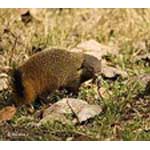
The Stripe-necked Mongoose (Herpestes vitticollis) is a species of mongoose found in southern India to Sri Lanka. The stripe-necked mongoose is the largest of the Asiatic mongooses. It has a stout body set on short legs. It is easily distinguished by the black stripe that runs laterally on both sides of its neck. The body coloration is a rusty brown to grizzled grey. The relatively short tail is mostly black, with grey at the base. The stripe-necked mongoose feeds on frogs, crabs, mouse deer, hares, rodents, fowl, and reptiles. This mongoose species is more diurnal in habits. They prefer forested areas near a fresh water source. They are often found in swamps and rice fields.
Ruddy Mongoose
Common Name: Ruddy Mongoose
Scientific Name: Herpestes smithii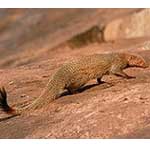
The Ruddy Mongoose (Herpestes smithii) is a species of mongoose found in hill forests of peninsular India and Sri Lanka. This mongoose along with the Striped-necked Mongoose are the only mongoose species endemic to India and Sri Lanka. The ruddy mongoose is a very closely related to Indian grey mongoose, but distinguished by its slightly larger size and black tipped tail extending for 2 to 3 inches at the distal end. There are two sub-species of this mongoose are identified in Sri Lanka.
Striped Hyaena
Common Name: Striped Hyaena
Scientific Name: Hyaena hyaena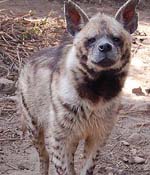
The Striped Hyena (Hyaena hyaena) is a species of true hyena native to North and East Africa, the Caucasus, the Middle East, Middle and Central and the Indian Subcontinent. It is listed by the IUCN as Near Threatened, as the global population is estimated to be under 10,000 mature individuals which continues to experience deliberate and incidental persecution along with a decrease in its prey base such that it may come close to meeting a continuing decline of 10% over the next three generations. It is the smallest of the true hyenas and retains many primitive viverrid characters lost in larger species, having a smaller and less specialised skull. Though primarily a scavenger, large specimens have been known to kill their own prey, and attacks on humans have occurred on rare instances. The striped hyena is a monogamous animal, with both males and females assisting one another in raising their cubs. A nocturnal animal, the striped hyena typically only makes itself visible in complete darkness, and is quick to return to its lair before sunrise. Although it is often considered a cowardly animal (due to its habit of feigning death when attacked), it has been known to stand its ground against larger predators such as leopards in disputes over food.
Jackal
Common Name: Jackal
Scientific Name: Canis aureus
The golden jackal (Canis aureus), also known as the common jackal, Asiatic jackal, is a Canid of the genus Canis indigenous to north and north-eastern Africa, south-eastern and central Europe (up to Austria and Hungary), Asia minor, the Middle East and south east Asia. It is classed by the IUCN as Least Concern, due to its widespread range in areas with optimum food and shelter. Despite its name, the golden jackal is not closely related to other jackal species, with morphological and molecular studies indicating a greater affinity to the grey wolf and coyote. It is a social species; whose basic social unit consists of a breeding pair, followed by its offspring. The golden jackal is highly adaptable, being able to exploit many different foodstuffs, from fruit and insects to small ungulates.
Indian Fox
Common Name: Indian Fox
Scientific Name: Vulpus bengalensis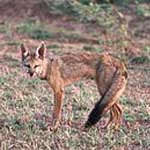
Vulpes bengalensis, also known as the Indian fox, is a fox endemic to the Indian subcontinent and is found from the Himalayan foothills and Terai of Nepal through southern India and from southern and eastern Pakistan to eastern India and southeastern Bangladesh. Vulpes bengalensis is a relatively small fox with an elongated muzzle, long pointed ears, and a bushy tail. Dorsal pelage is very variable but mostly grayish and paler ventrally; legs tend to be brownish or rufous. Tail is bushy with prominent black tip which distinguishes it from other species. Back of ears are dark brown with black margin.
Indian Wild Dog
Common Name: Indian Wild Dog
Scientific Name: Cuon alpines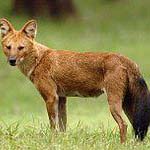
The Indian Wild Dog (Cuon alpinus) is a species of canid native to Southeast Asia. It is the only extant member of the genus Cuon, which differs from Canis by the reduced number of molars and greater number of teats. These are classed as endangered by the IUCN, due to ongoing habitat loss, depletion of its prey base, competition from other predators, persecution and possibly diseases from domestic and feral dogs. The wild dog is a highly social animal, living in large clans which occasionally split up into small packs to hunt. It primarily preys on medium-sized ungulates, which it hunts by tiring them out in long chases. Though fearful of humans, wild dog packs are bold enough to attack large and dangerous animals such as wild boar, water buffalo, and even tigers.
Sloth Bear
Common Name: Sloth Bear
Scientific Name: Melursus ursinus
The sloth bear (Melursus ursinus) also known as the labiated bear, is a nocturnal insectivorous species of bear found wild within the Indian subcontinent. The sloth bear evolved from ancestral brown bears during the Pleistocene and shares features found in insect-eating mammals through convergent evolution. The population isolated in Sri Lanka is considered as a subspecies. Unlike brown and black bears, sloth bears have lankier builds, long shaggy coats that form a mane around the face, long sickle shaped claws, and a specially adapted lower lip and palate used for sucking insects. Sloth bears breed during spring and early summer and give birth near the beginning of winter. They feed on termites, honeybee colonies and fruits. Sloth bears sometimes attack humans that encroach on their territory. Historically, humans have drastically reduced their habitat and diminished their population by hunting them for food and products such as their baculum and claws. These bears have been used for as performing pets due to their tameable nature.
Common Otter
Common Name: Common Otter
Scientific Name: Lutra lutra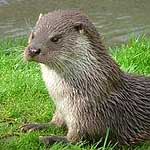
The European Otter (Lutra lutra), also known as the Eurasian otter, Eurasian river otter, is a European and Asian member of the Lutrinae or otter subfamily, and is typical of freshwater otters. The European Otter is a typical species of the otter subfamily. Brown above and cream below, these long, slender creatures are well-equipped for their aquatic habits. This otter differs from the North American river otter by its shorter neck, broader visage, the greater space between the ears and its longer tail. The European Otter is the most widely distributed otter species, its range including parts of Asia and Africa as well as being spread across Europe.
Nilgiri Marten
Common Name: Nilgiri Marten
Scientific Name: Martes gwatkinsi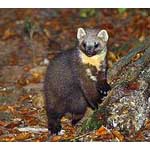
The Nilgiri marten (Martes gwatkinsii) is the only species of marten found in southern India. It occurs in the hills of the Nilgiris and parts of the Western Ghats. The Nilgiri marten is similar to the yellow-throated marten, but is larger and essentially different in the structure of the skull- it has a prominent frontal concavity. It is unmistakable in the field as it is dark above with a bright throat ranging in colour from yellow to orange. It is about 55 to 65 cm long from head to vent and has a tail of 40 to 45 cm. It weighs about 2.1 kg. The species is reported from the Nilgiris, parts of southern Kodagu and northern Kerala, up to the Charmadi ghats. Very little is known about the Nilgiri marten. It is diurnal, and though arboreal, descends to the ground occasionally. It is reported to prey on birds, small mammals and insects such as cicadas.
Indian Tree Shrew
Common Name: Indian Tree Shrew
Scientific Name: Anathana ellioti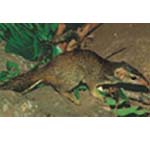
Indian Tree Shrews have a body length between 17 and 20 cms (6.5 -8 inches), a tail length between 16 and 19 cms (6.5-7.5 inches) and they weigh approximately 150 g (5 oz). They are grey/brown in colour with a cream stripe on their shoulder. They have a slender build, a long bushy tail, a pointed muzzle and large eyes. They have well developed senses of hearing, smell and vision. Indian Tree Shrews are found in the hill forests of central and southern India. They are active during the day and they sleep in a rock crevice or tree hole at night. Indian Tree Shrews are omnivores and they feed on a variety of insects, small vertebrates, fruit and seeds. After a gestation period of approximately 50 days, a litter of 3-4 young are born. At birth the young are blind and hairless, but they are able to leave the nest when they are a month old. Tree Shrews reach sexual maturity at around 4 months old and they generally breed throughout the year with no defined breeding season
.
Flying Squirrel
Common Name: Flying Squirrel
Scientific Name: Petaurista petaurista
The Red Giant Flying Squirrel (Petaurista petaurista) is a species of flying squirrel, which ranges from the eastern regions of Afghanistan, into northern India and Pakistan through to Java, and Taiwan, and also Sri Lanka. It can also be found in parts of Borneo. This species was recorded in Peninsular Malaysia, included Penang, Tioman Island and also Singapore. Giant flying squirrels (Petuarista sp.) have highest diversity in term of species richness and population diversity in Southeast Asia.
Malabar Giant Squirrel
Common Name: Malabar Giant Squirrel
Scientific Name: Ratufa indica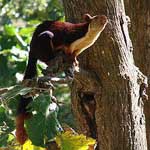
The Indian giant squirrel, or Malabar giant squirrel, (Ratufa indica) is a large tree squirrel species genus Ratufa native to India. It is a large-bodied diurnal, arboreal, and herbivorous squirrel found in South Asia. The Ratufa indica has a conspicuous two-toned (and sometimes three-toned) color scheme. The colors involved can be creamy-beige, buff, tan, rust, brown, or even a dark seal brown. The under parts and the front legs are usually cream colored, the head can be brown or beige, however there is a distinctive white spot between the ears. Adult head and body length varies between 14 inches (36 cm) and the tail length is approximately 2 ft (0.61 m). Adult weight - 2 kg (4.41 lb). The species is endemic to deciduous, mixed deciduous, and moist evergreen forests of peninsular India. As can be seen in the range map of this species, it occupies isolated ranges that are widely separated from each other, thus producing conditions favorable for speciation.
Three Striped Squirrel
Common Name: Three Striped Squirrel
Scientific Name: Funambulus palmarum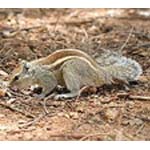
The Indian Palm Squirrel (Funambulus palmarum) also known as Three-Striped Palm Squirrel, is a species of rodent in the Sciuridae family that can be easily domesticated and kept as pets. It is found naturally in India (south of the Vindhyas) and Sri Lanka. In the late 19th century, the Palm Squirrel was accidentally introduced into Western Australia where it has since become a minor pest that is actively eradicated due to its lack of natural predators. Palm squirrels are about the size of rats with a bushy tail which is slightly shorter than their body. Their back is a grizzled gray-brown colour with three conspicuous white stripes which run from head to tail. The two outer stripes run from the forelegs to the hind legs only. They have a creamy white belly and a tail covered with interspersed long black and white hairs. These squirrels eat mainly nuts and fruits.They are opportunists in urban areas, and can be easily domesticated and trained to accept food from humans.
Indian Porcupine
Common Name: Indian Porcupine
Scientific Name: Hystrix indica
The Indian Crested Porcupine (Hystrix indica), or Indian Porcupine, is a member of the Old World porcupines. It is quite an adaptable rodent, found throughout southern Asia and the Middle East. It is tolerant of several different habitats: mountains, tropical and subtropical grasslands, scrublands, and forests. It is covered in multiple layers of quills. The longest quills grow from its shoulders to about a third of the animal's length. Its tail is covered in short, hollow quills that can rattle when threatened. It has broad feet and long claws for digging. When attacked, the Indian Crested Porcupine raises its quills and rattles the hollow quills on its tail. If the predator persists past these threats, the porcupine launches a backwards assault, hoping to stab its attacker with its quills. It does this so effectively that most brushes between predators and the Indian porcupine end in death or severe injury.
Indian Elephant
Common Name: Indian Elephant
Scientific Name: Elephas maximus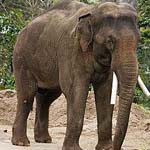
The Asian or Asiatic elephant (Elephas maximus) is the only living species of the genus Elephas and distributed in Southeast Asia from India in the west to Borneo in the east. Three subspecies are recognized. Asian elephants are the largest living land animals in Asia. Since 1986, Elephas maximus has been listed as endangered by IUCN as the population has declined by at least 50% over the last three generations, estimated to be 60–75 years. The species is pre-eminently threatened by habitat loss, degradation and fragmentation. Asian elephants are rather long-lived, with a maximum recorded life span of 86 years. This animal is widely domesticated, and has been used in forestry in South and Southeast Asia for centuries and also for ceremonial purposes. In general, Asian elephants are smaller than African elephants and have the highest body point on the head. Their back is convex or level. Their ears are small with dorsal borders folded laterally. They have up to 20 pairs of ribs and 34 caudal vertebrae. Their feet have more nail-like structures than the ones of African elephants- five on each forefoot, and four on each hind foot. Asian elephants inhabit grasslands, tropical evergreen forest, semi-evergreen forest, moist deciduous forest, dry deciduous forested and dry thorn forest, in addition to cultivated and secondary forests and scrublands.
Indian Bison
Common Name: Indian Bison
Scientific Name: Bos gaurus
The gaur is also called Indian bison (Bos gaurus), is a large bovine native to South Asia and Southeast Asia. The species is listed as vulnerable on the IUCN Red List since 1986 as the population decline in parts of the species' range is likely to be well over 70% over the last three generations. Population trends are stable in well-protected areas, and are rebuilding in a few areas which had been neglected. The gaur is the largest species of wild cattle, bigger than the African buffalo, the extinct aurochs, and wild water buffalo.
Sambar
Common Name: Sambar
Scientific Name: Cervus unicolor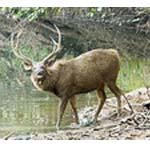
The Sambar Deer (Cervus unicolor) is a large deer native to southern and southeast Asia. The appearance and size of sambar vary widely across their range, which has led to considerable taxonomic confusion in the past; over forty different scientific synonyms have been used for the species. In general, they attain a height of 102 to 160 centimetres (40 to 63 in) at the shoulder and may weigh as much as 546 kilograms (1,200 lb)though more typically 225 to 320 kilograms (500 to 710 lb). Head and body length varies from 162 to 246 centimetres (64 to 97 in), with a 25 to 30 centimetres (9.8 to 12 in) tail. Individuals belonging to western subspecies tend to be larger than those from the east. The Sambar inhabits much of southern Asia (as far north as the south-facing slopes of the Himalayan Mountains), mainland Southeast Asia (Burma, Thailand, Indochina, the Malay Peninsula), southern China (including Hainan Island), Taiwan, and the islands of Sumatra and Borneo in Indonesia. Sambar are nocturnal or crepuscular. The males live alone for much of the year, and the females live in small herds of up to sixteen individuals. Indeed, in some areas, the average herd consists of only three or four individuals, typically consisting of an adult female, her most recent young, and perhaps a subordinate, immature female. This is an unusual pattern for deer, which more commonly live in larger groups. They often congregate near water, and are good swimmers.
Barking Deer
Common Name: Barking Deer
Scientific Name: Muntiacus muntjak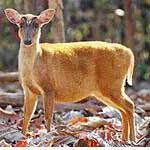
Muntiacus also known as Muntjac or Barking Deer, are small deer of the genus Muntiacus. Muntjac are the oldest known deer, appearing 15–35 million years ago. The present-day species are native to South Asia and can be found from Sri Lanka to southern China, Taiwan, Japan, India and Indonesian islands. They are also found in the eastern Himalayas and in Burma. Inhabiting tropical regions, the deer have no seasonal rut and mating can take place at any time of year; this behaviour is retained by populations introduced to temperate countries. Males have short antlers, which can regrow, but they tend to fight for territory with their "tusks" (downward-pointing canine teeth). Muntjacs are of great interest in evolutionary studies because of their dramatic chromosome variations and the recent discovery of several new species. The Indian Muntjac is the mammal with the lowest recorded chromosome number.
Spotted Deer
Common Name: Spotted Deer
Scientific Name: Axis axis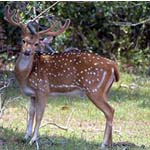
The spotted deer ((Axis axis) also known as chital deer, which commonly inhabits wooded regions of Sri Lanka, Nepal, Bangladesh, Bhutan, India, and in small numbers in Pakistan. It is the most common deer species in Indian forests. The animals coat is pinkish fawn, marked with white spots, and its under parts are white. Its antlers, which it sheds annually, are usually three-pronged and curve in a lyre shape and may extend to 75 cm. It stands about 90 cm (3 ft) tall at the shoulder and masses about 85 kg (187 lb), although males tend to be larger than females. Its lifespan is around 8–14 years. The spotted deer is found in large numbers in dense deciduous or semi-evergreen forests and open grasslands. The highest numbers are found in the forest of India where they feed upon tall grass and shrubs.. They also prefer heavy forest cover for shade and are intolerant of direct sunlight.
Mouse Deer
Common Name: Mouse Deer
Scientific Name: Tragulus meminna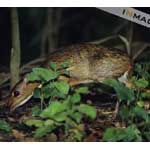
India’s smallest deer, the Mouse deer, also known as Indian Chevrotain (Tragulus meminna), is a very timid and nocturnal animal difficult to spot in the wild. This species was widespread and successful from the Oligocene (34 million years ago) to the Miocene (about 5 million years ago), but has remained almost unchanged over that time and remains as an example of primitive ruminant form. These have short, thin legs which leave them lacking in agility but also helps to maintain a smaller profile which aids in running through the dense foliage of their environment. Within India, the Indian chevrotain is commonly encountered in a number of forest areas along the Western Ghats, in the Eastern Ghats up to Orissa, and in the forests of central India. The Kalakad-Mundanthurai Tiger Reserve at the extreme south of the Western Ghats appears to be one of the best localities for the species and may represent a major population stronghold. The species may also be frequently met with in most other protected areas along the Western Ghats such as the Periyar Tiger Reserve, Indira Gandhi Wildlife Sanctuary, Silent Valley, Mudumalai-Bandipur-Nagarahole, Bhadra, and Kudremukh. Krishnan (1972) notes that the species is seen almost commonly around Karwar and in some forests of south India.
Indian Wild Boar
Common Name: Indian Wild Boar
Scientific Name: Sus scrofa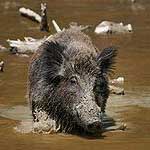
Wild boar is also known as wild pig, (Sus scrofa) is a species of the pig genus Sus, part of the biological family Suidae. It is the wild ancestor of the domestic pig, an animal with which it freely hybridises. These are native across much of Northern and Central Europe, the Mediterranean Region (including North Africa's Atlas Mountains) and much of Asia as far south as Indonesia. The body of the wild boar is compact; the head is large, the legs relatively short. The fur consists of stiff bristles and usually finer fur. The colour usually varies from dark grey to black or brown, but there are great regional differences in colour; even whitish animals are known from central Asia. During winter the fur is much denser. Adult males are usually solitary outside of the breeding season, but females and their offspring (both sub-adult males and females) live in groups called sounders. Sounders typically number around 20 animals, although groups of over 50 have been seen, and will consist of 2 to 3 sows; one of which will be the dominant female. Group structure changes with the coming and going of farrowing females, the migration of maturing males (usually when they reach around 20 months) and the arrival of unrelated sexually active males. The normally solitary males then move into female groups, and rival males fight for dominance, whereupon the largest and most dominant males achieve the most mating.
Source: Kerala Forest and Wild Life Department